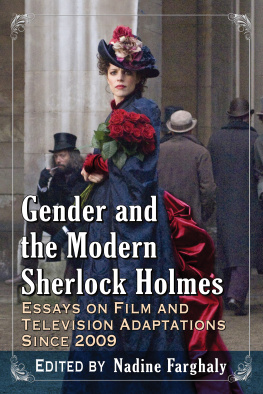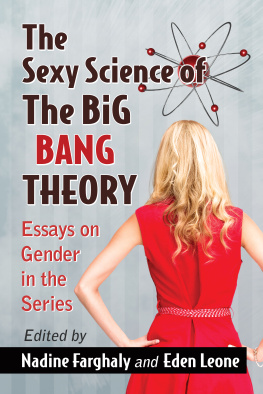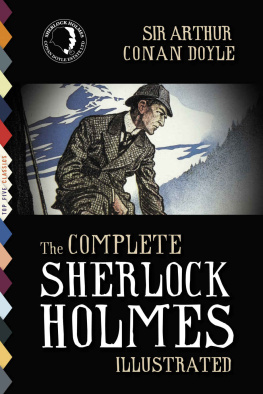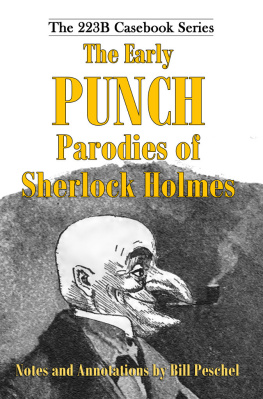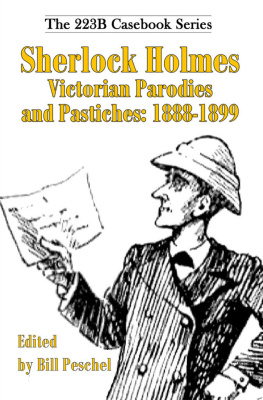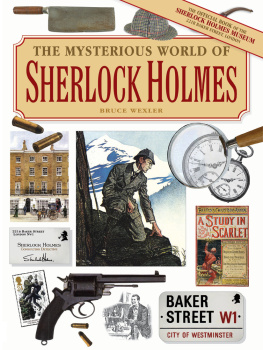
ALSO EDITED BY NADINE FARGHALY
Unraveling Resident Evil: Essays on the Complex Universe of the Games and Films (McFarland, 2014)
EDITED BY NADINE FARGHALY AND EDEN LEONE
The Sexy Science of The Big Bang Theory: Essays on Gender in the Series (McFarland, 2015)
Gender and the Modern Sherlock Holmes
Essays on Film and Television Adaptations Since 2009
EDITED BY
NADINE FARGHALY

McFarland & Company, Inc., Publishers
Jefferson, North Carolina
For the families we choose ourselves
Acknowledgments
So many people were involved in this project, both helping with the actual work and providing whatever support I needed. I want to thank all the people who were not only wonderful peer-review readers, but also dear friends who supported me throughout this endeavor and never stopped believing that it would be a success, especially Eden. All my love to my mother and my sisters for their incredible support and belief in me. Cheers and my love to all my friends who let me rant and wail to my hearts content before they tried to help me fix whatever crisis I had (whether imagined or real). Thank you all so much.
Introduction
NADINE FARGHALY
Ive found it! Ive found it are the first words spoken by Sherlock Holmes in A Study in Scarlet (Conan Doyle). These words not only embody the formidable personality of Sherlock Holmes, but also set the stage for the journey readers undertake when picking up the memoirs of his companion, Dr. John Watson. This curious, driven, and arrogant detective, a creation of Sir Arthur Conan Doyle, has captured readers imaginations for 187 years and gone beyond Conan Doyles printed words to encompass numerous adaptations that include board, console and computer games, graphic novels, cookbooks, novels, plays, music, and movies. Television series such as Elementary and Sherlock have taken the Holmes and Watson characters to a whole new level in their portrayal of the enigmatic detective and his trusted friend.
More than seventy actors have played the part of Sherlock Holmes in more than two hundred movies (Fox). Among the actors who have assumed the mantel of Sherlock are Sir Ian McKellen, Charlton Heston, Jeremy Brett, Christopher Lee, Roger Moore, Basil Rathbone, and Frank Langella. While the duo have never really been forgotten, Sherlock Holmes and Dr. Watson have never garnered as much attention as they do now.
Conan Doyles character has been Japanese, French, Russian, Finnish and many other nationalities, but this volume focuses on director Guy Ritchies adaptations Sherlock Holmes (2009) and Sherlock Holmes: A Game of Shadows (2011); CBSs Elementary (2012present); and the BBCs Sherlock (2010present).
While Ritchies movies place Holmes and Watson in their original Victorian setting, both Elementary and Sherlock place the duo in contemporary times; Elementary in New York and Sherlock in London. And although there are some similarities between these two television adaptations, the ways in which they differ are more prominent. Elementary showcases a sexually active, recovering drug addict who recuperates in one of his fathers brownstone properties. Here he works with a sober companion, Joan Watson, paid by his father. Although this is not the first time that the gender of one of these characters has been changed, it is the first time that one of them has been successfully received as a woman, actress Lucy Liu playing Dr. Watson. While critics may have had their doubts in the beginning, Dr. Joan Watson has transformed the role of Holmes sidekick to equal partner. For example, Watson functioned as an advisor to the New York Police Department when Sherlock relocated for six months to the UK. Although the creators are playing with the chemistry of Joan and Sherlock, they have yet to take their relationship from a friendly, professional, and platonic one into a romantic one. A fact that in no way diminishes the shows success, on the contrary, Lius portrayal of Watson as a professional partner and companion is a nice change from the idea that men and women cannot work together without having romantic feelings as is so often the case.
Across the pond, the BBCs Sherlock has attracted attention because of its sexual undertones. The relationship between John and Sherlock has never been as blatantly homosexual as it is here, as shown by the frequent comments from Mrs. Hudson regarding Holmes and Watsons living arrangements. Martin Freeman, the actor who plays John Watson in Sherlock, has commented,
[Its about the relationship] and how it develops and how it changes and the things that wind each other up, the things that they genuinely sort of love about each other as well. Its the gayest story in the history of television. People certainly run with that which Im quite happy with! But we all saw it as a love story. Not just a love story, but those two people who do love each othera slightly dysfunctional relationship sometimes, but a relationship that works. They get results [Wightman].
Although never really proven in the show itself, the relationship is more than just subtext; it has become canon for Sherlock. The deep affection between these two characters is genuine and palpable. It is no surprise that fans everywhere happily jumped on the bandwagon and started shipping like never before in the Sherlock Holmes universe.
The 21st century popularity of Sherlock Holmes is something Arthur Conan Doyle may not have envisioned. Conan Doyle created a character that still entices his audience even though he was conceptualized during the Victorian era. Sherlock Holmes is a brilliant, if flawed, detective who appears in four novels and 56 short stories, of which he narrates two. The popularity of this sleuth and his partner in crime, Dr. John H. Watson, has never been more interesting than it is now. However, the different incarnations of his characters and locations challenge fans to contemplate new ideas, such as the role of gender. Although there are a few books and various essays that discuss this theme, this collection focuses on the gender of these characters and poses questions such as What is the importance of a female Dr. Watson? In what ways was Irene Adler updated for modern viewers? Does the romantic subtext in many adaptations play a role or is it just there to attract viewers? The following essays endeavor to answer these questions and more.
Greg Freeman kicks off this collection with his essay The Evolution of Sherlock Holmes: An Examination of a Timeless Figure Amid Changing Times. Here, Freeman discusses the various changes Sherlock and John had to undergo and how these changes were influenced by the needs and wants of society. He skillfully leads his readers on a journey through the most recent Sherlock Holmes adaptations, all the while analyzing their importance.
In Theres a Name Everyone Says: Irene Adler and Jim Moriarty in Sherlock, Benedick Turner takes a close look at Sherlocks most famous adversary, Moriarty. Turner shows how the original Moriarty is never quite on a par with the skilled sleuth and argues that Conan Doyles Irene Adler is really more deserving of being called Holmess nemesis. He reveals how the BBCs Sherlock changes this by appropriating Irene Adlers essential capacity and grafting it onto Moriarty to create a masterful villain.
Next page
